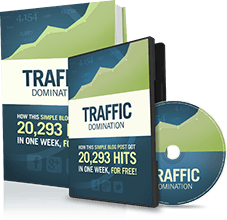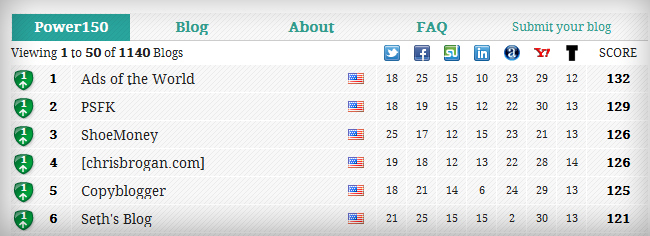Blogger Profile: Seth Godin and The World’s Weirdest Marketing Blog
How do you know when you’ve made it big online?
Here’s one answer: when you search your first name on Google and you’re the top result.
It’s no surprise that the #1 result for “seth” is the Seth Godin’s marketing blog. The site receives about 600,000 visitors per month and consistently ranks near the top of Ad Age’s Power 150 (a daily ranking of marketing blogs).
Godin’s blog is successful because it’s weird. It’s a “purple cow” – a term he popularized that describes “something phenomenal, something counterintuitive and exciting and flat out unbelievable.”
Below, I’ll break down what Godin’s doing that’s so phenomenal, counterintuitive, and flat out unbelievable.
What You’ll Learn:
- How being a blogger is like being a musician
- Why Godin’s traffic advice contradicts itself
- Why Seth’s blog doesn’t allow comments
- How Godin made $40,000 in three hours
Content
Only Publish Quality
“Key assertion: you don’t publish it unless it’s good.”
Seth Godin
Your blog is your brand. Mediocre content is worse than no content at all.
Curate Your Voice
Your writing “voice” is the distinctive, unique character that comes through in your language. I’ve talked previously about why it’s so important if you want to be a better writer online.
Each of us is blessed with a natural voice, but truly great writers like Godin intentionally cultivate that voice to make it stronger and more impactful:
I’ve carefully curated a voice in my head that blogs in a way that appears to resonate with people.
Godin compares developing his writing voice to the way a musician develops their own personal sound: “Training helps, listening to records helps, but mostly you blow a lot until you resonate and then repeat, prune, experiment, prune, repeat, prune until a groove occurs.”
Keep perfecting your voice as a writer and eventually you’ll find your own groove – one that’s true to who you are and resonates with your audience.
Using your voice makes your writing better, but it may also make it easier and less time-consuming. Here’s what Seth told Problogger:
“I write like I talk. The reason that’s important is that no one gets talker’s block. And so if you wake up in the morning unable to speak, then you need a physician. Everyone else doesn’t have that problem. So if you can train yourself to talk in complete sentences, and actually come up with thoughts that are worth sharing, then writing isn’t particularly hard—you just write down what you say.”
Write Often
Godin used to write longer posts occasionally, but now he publishes daily. That’s right: seven days a week.
That’s almost unheard of for a one-man-operation. But it could be even more. Godin told Ad Age that he has “about six bloggable ideas a day.” He keeps it down to one per day as a “compromise” because he doesn’t want to overwhelm his audience with new content.
Godin writes at least one post per day and queues up the extras when he writes more. He’ll regularly look through posts that are queued to publish and replace them with new ones that he likes more.
If you commit to doing a simple marketing item just once each day, at the end of the year you’ve built a mountain.
Writing daily isn’t for everyone, but in general the more often you post, the better. Google favors websites that are frequently updated and I know that I do too: the more often a website has new content, the more often I find myself visiting it.
Write as Few Words as Possible
Last week, I wrote an article about the importance of writing epic blog posts that are at least 2,000 words long. Godin agrees with me and has told to people who want more traffic to, “write long, definitive posts.”
Yet today, Seth’s posts are anything but long and definitive. Many are under 200 words. Here’s part of Godin’s reasoning:
“Less is actually more, and the length of your speech or your document has nothing at all to do with your impact or your status.”
He’s also said:
“I also find that writing twice as long a post doesn’t increase communication, it usually decreases it.”
So which is the truth? Should you write authoritative posts of at least 2,000 words? Or follow in Seth’s footsteps and keep things short and pithy?
It depends. The length of your post should be as short as possible, while still saying everything that you need to say on the topic. So while an ultimate guide on a complex subject should be thousands of words long, the explanation of a simple principle or idea should be only a couple hundred.
Your readers’ time is valuable and you owe it to them to write concisely. Whatever you’re writing, follow Seth’s advice and simply “say what you need to say, then leave.”
Driving Traffic
Image courtesy of Trey Ratcliff
Traffic is a Symptom
Seth doesn’t worry too much about driving traffic to his blog.
He gets a constant stream of visitors from Twitter, Facebook, Search, and links… but it isn’t because he implements any amazing traffic strategies. In fact, he runs arguably the world’s worst Facebook and Twitter pages (no social interaction whatsoever; every update is just a link to a new blog post).
All the traffic Seth receives is a symptom of the fact that every day he offers something people highly valuable: a fresh idea, written with alacrity and honesty.
Godin’s Traffic Guide
Way back in 2006, Seth wrote a blog about getting traffic that you can read here.
Here are a couple of his points that really stuck out to me:
“1. Use lists.”
Lists have been invaluable to Income Diary’s success. Last week, Michael told me that 90% of the site’s search engine traffic is from list posts.
“18. Coin a term or two.”
Godin has coined more than his fair share of marketing terms, most famously, he pioneered the concept of “permission marketing” way back in the 90’s. How does this help with traffic? I’m not sure, but it will probably get more people to link back to your blog.
“49. Give credit to those that inspired, it makes your writing more useful.”
This reminds me that giving more means getting more – and that when you provide links to the sources of your content, you’re giving back both to the source and to your reader.
Finally, here’s the last traffic tip Godin offered. It must be important, since it’s in bold:
56. Write stuff that people want to read and share.
There is No One Correct Path
I couldn’t help but notice that many of Seth’s traffic tips contradicted one another.
He advises that you “Be topical… write posts that need to be read right now” and then that you “Be timeless… write posts that will be readable in a year.”
He advises that you “Write short, pithy posts” and then that you “Write long, definitive posts.”
In fact, Godin contradicts himself so often that I’m pretty sure he’s trying to make a point: there are no hard and fast rules for getting more traffic. There are many routes to the top of that mountain; pick the right one for you.
Design
No Header
I’ve talked about how Matthew Inman and Neil Patel both implement very narrow headers for their blogs, which means there’s more room above the fold for their content.
But Godin does them both one better: his blog design doesn’t have a header whatsoever (unless you count that little gray bar that links back to the home page). Instead, he uses the top of the sidebar to put the blog title.
Godin’s no-header design makes a statement: nothing comes before content on this blog.
No Comment
Another unusual design decision, Godin doesn’t allow comments on his blog posts. He gets enough questions about it, he actually wrote a post explaining why. Here’s an excerpt:
I think comments are terrific, and they are the key attraction for some blogs and some bloggers. Not for me, though. First, I feel compelled to clarify or to answer every objection or to point out every flaw in reasoning. Second, it takes way too much of my time to even think about them, never mind curate them. And finally, and most important for you, it permanently changes the way I write. Instead of writing for everyone, I find myself writing in anticipation of the commenters.
Godin’s decision to avoid comments is less strategic and more personal. Comments are a great way to connect with your readers and engage in valuable discourse, but they’re also time-consuming to curate and they can distract from the original message of your post.
Since readers can’t discuss Godin’s posts on his site, they often turn to writing responses on their own blogs – which means more trackbacks and traffic for Seth.
Design isn’t Everything
A good design can establish a site’s credibility, illustrate its brand, and guide readers to take a particular action, all at once.
But the design of Godin’s blog isn’t particularly good. Yes, it’s simple and effective, but it’s also outdated and ugly. Sorry, Seth.
The blog works in spite of its design. Ultimately, good content always trumps good design. The sandwich is always more important than the plate it’s served on.
Monetization
Don’t Try to Make Money
“My blogging life is basically goalless. I like the zen nature of that, and paradoxically, it improves results.”
Seth didn’t start his blog to make money and even as its readership grew, he never made an outright effort to monetize. He told Ad Age, that “the only reason I blog is because I love it. I love being able to create something that feels like a gift, giving an idea that spreads, that may improve something for someone.”
Godin’s seen others stumble when forcing monetization on their blogs: “When people start to think, ‘What can I hold back? What can I sell? How can I move people through a sales funnel?’ they start getting themselves into trouble.”
In the connection economy, what’s really clear to me is that there are more opportunities to be generous and to lead and to curate than ever before. If you spend a year or two or five doing that, in your spare time, with no real focus on getting repaid, sooner or later people are going to want more of you … and then you can’t help but get paid.
A site like Income Diary is built from the ground up as a business, so obviously this advice doesn’t apply to all blogs. Godin understand that there are different models:
“I think there’s plenty of room for blogs that exist to pay the blogger, or blogs that exist to turn a profit. That’s just not the kind of blog I’m writing, and I’m not the kind of blogger that could do that.”
Before you go about implementing a monetization strategy, carefully consider whether it’s in line with the type of blogger you want to be. Monetization is best when it comes about organically, through an alignment of your values and the needs of your audience.
Only Professionals Get Paid
“[Blogging] is amateur media; this is not professional media. And every once in a while an amateur gets so good that people come to them and beg them to take money. But if an amateur sets out to be a professional, she starts making short cuts and she starts trading in relationships for cash.”
The above quote if from Godin’s ProBlogger interview, but the amateur/professional distinction must be important to him, because I’ve heard him touch on it several times.
The overriding message is clear: don’t expect to get paid like a professional unless you truly behave like one. Sometimes that means paying your dues for a long time, like how Godin delivered 100’s of speeches before he was ever paid to speak.
As the technology to take great photos, make graphic design, and publish content online becomes increasingly available to the masses, Godin sees more and more amateur creators who are willing to work for free. This means that professionals will have to prove that they’re head and shoulders above the rest if they want to get paid. From his Ad Age interview:
“The future is going to be filled with amateurs, and the truly talented and persistent will make a great living. But the days of journeyman writers who make a good living by the word–over.”
There will always be people blogging for free. If you want to make a living writing online, you’ll have to be talented, persistent, and professional.
Buy Your Own Ad Space
Seth doesn’t sell any advertising space on his blog and he’s made it clear that he thinks selling ads is bad for a blog’s traffic.
But he does have the covers of 14 of his books in his sidebar – and under each one is the text ‘buy it now’. Godin’s books are all about marketing and are all very relevant to his blog’s audience, so it makes sense that he would showcase them prominently.
By using his sidebar to promote books that he can stand behind fully (he wrote them, after all), Godin gets the best of both worlds: money from selling products in his sidebar, without selling out.
Use Kickstarter
In June 2012, Seth started a Kickstarter campaign to fund the publication of his most recent book, The Icarus Deception:
“Please help me show my publisher, the bookstores and anyone with a book worth writing that it’s possible to start a project with a show of support on Kickstarter.”
Godin asked his tribe to back the project in exchange for advance copies of the book, at a discounted price, and with special bonuses. The most-special-bonus was the opportunity to be interviewed by Seth and featured in the book. Even at $1,150 a pop, this reward quickly sold out.
Within three hours Godin’s campaign had met its $40,000 funding goal. By the end of the campaign’s run, Godin had raised $287,342 – breaking a few Kickstarter records along the way.
Godin loves what Kickstarter does for the publishing industry:
“[Kickstarter is] a way that any author with a following can divide the publishing process into three pieces–get the true fans on board early, give them something to talk about just before the book is in stores, and then use online and offline bookstores to do what they do best and distribute far and wide. It moves the power in the process to where it belongs–to motivated readers and their authors.”
If you’re interested in creating a Kickstarter project, I recommend you check out Income Diary’s ultimate Kickstarter guide.
The Final Takeaway
Why does Seth Godin get out of bed in the morning? Here’s how he answered that question:
“I would say that my passion is having people surprise themselves by what they’re capable of. And if I can be present at least a little bit for some of that internal dialog, that’s a privilege and a thrill for me.”
Seth believes in most people more than most people believe in themselves. He wants nothing more than to show them what they can achieve if they truly try – and his blog is a perfect vehicle for that.
So Seth gets to pursue his passion every day and he says you should too:
“It seems as though work with passion is so much more fulfilling and efficient that it’s a reasonable choice for everyone, not just an exception.”
Now get to it!
"Do Not Write Another Blog Post Until You Watch This Free Video..."

Watch this free video to learn...
- How I got over 10,000,000 people to visit my websites.
- The types of blog post that got me all that traffic.
- How to get someone else to do it for you!









![New WordPress Install – 20 Things You Must Do [Checklist] New WordPress Install – 20 Things You Must Do [Checklist]](wp-content/uploads/2016/09/new-wordpress-install-2016-210x120.jpg)






nice post, i can’t wait till my blog rank high on google, still on construction but i’ll never give up
That’s the attitude, Gilbert. Good luck.
Awesome article! Really useful tips and inspiration. Now, back to work…
That’s right. Keep working!
Nice post, I read all of it. Very good inspiration for me, I have found some new and fresh blogging ideas here
I’m glad you read it all. I know these are long posts. Glad that you found some fresh ideas.
Favorite part: “Ultimately, good content always trumps good design. The sandwich is always more important than the plate it’s served on.” Well-written, Nick. I appreciate the research that went into this post. Thanks for pulling it together.
Thanks. It’s a joy to research someone as bright and interesting as Godin.
Wow.! You have done a great job of dissecting some critical aspects of blogging.
I read ‘Seth’s Blog’ often, and over time, I have found it to be quite educational, a lot of good theory to learn.
You have taken apart some of his thinking and emphasized some really pertinent points.
Thanks for the post
daveM
Nice article Nick. Thanks for sharing.
Great post Nick,
Godin creates amazing work and I think it’s brilliant the way you cover his profile to the FULLEST!
I am currently reading the Guerrilla Marketing Handbook by Godin for one of my college courses, it’s fantastic!
His blog model doesn’t even matter. When you already have so much pre-established credibility as Seth, your blog can look like anything and write whatever you feel like — and people will come regardless of quality because they know he’s successful. He could write nonsense and people will still come flocking as long as they know he’s the man behind Squidoo.
Seth is already rich… he doesn’t sell advertisements because he doesn’t have to. It’s easy for him to play noble and be all about the readers… he’s rich. If someone tries to emulate his blog model thinking that’s the way to build a successful blog, Seth was already successful, that’s why people come to his blog.
I agree with you in part. Seth’s pre-established credibility is a big part of his success and it means that he doesn’t have to make any money off of the site. But you’re wrong to say that he could ‘write nonsense’ and people would still come flocking. Most bloggers aren’t in Godin’s position, but everyone can still learn from how he manages his site.
seth Godin Blog’s Weird and that’s why i ‘m always reading and waiting for him to write!. Likewise YOU.